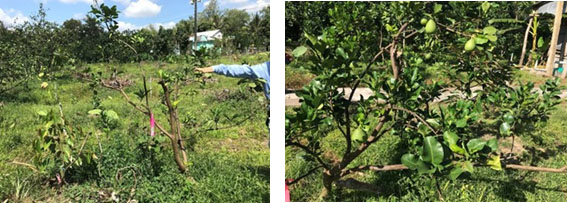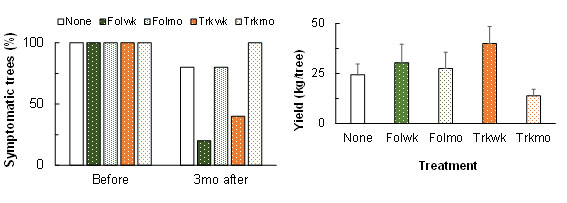by Nguyen Van Hoa 1)*, Dang Thi Kim Uyen 1), Nguyen Thi Kim Thoa 1), Hiroyasu Kikuchi 2), Katsuya Ichinose 2) and Motofumi Suzuki 1)
1) Southern Horticultural Research Institute, Long Dinh, Chau Thanh, Tien Giang, Vietnam
2) AICHI STEEL CORPORATION, Tokai, Aichi, Japan
Citrus greening disease, also known as Huanglongbing, has destroyed vast areas of citrus cultivation in this century. In Asia, the pathogen of this disease, Candidatus Liberibacter asiaticus, is transmitted from tree to tree by a small insect from the Heteroptera order known as the Asian citrus psyllid (Diaphorina citri). Theoretically, the elimination of the pathogen or the eradication of the vector should end the disease permanently. Unfortunately, neither measure has yielded desirable outcomes to date. This is the reason why citrus greening continues to threaten the global citrus cultivation and industry.
At present, the most practical management of this disease is the integration of the vector control by synthetic insecticides and the clearing-off of diseased trees in citrus orchards. Some growers may choose to use antibiotics to inhibit pathogen multiplication in the plants. Nonetheless, citrus orchards are inevitably exposed to the invasion of pathogen-carrier psyllids, which consequently can cause total destruction of infested orchards in a few years. Recent public concerns on human health, environment protection are driving citriculture industry to reduce or even abandon the usage of these chemicals, as well as resistance/tolerance development both in bacteria and in the vector. With the lack of development in cross protection methods using milder strains, practical and sustainable management practices for citrus greening are thus enthusiastically required.
Recently, a group of Japanese researchers established a hypothesis that the key to reducing severity or even eliminating the disease lies in the management of iron deficiency, because the disease symptoms in infected plants are similar to those that are deficient in iron. This led to the assumption that a sufficient supply of iron could help plants recover from this disease. To test this hypothesis, they applied iron to diseased trees grown in pots inside a greenhouse. They were successful in re-greening the yellowing foliage (leaf chlorosis) of diseased trees and even in eliminating the pathogen from some infected trees. The results of the study on the efficacy of iron against the citrus greening disease were published in several scientific papers. The success prompted the researchers to scale up the findings to the field. Thus, together with researchers from Vietnam, a preliminary field experiment was carried out in citrus orchards in Southern Vietnam, where six randomly selected citrus trees were treated with no application of iron as control. Another six trees were treated with foliar application of iron in the form of ferrous, or Fe2+, in a water-based solution. Prior to the inception of the field trials, disease infection status of trees was determined by PCR, confirming that five of the six control trees and three of the six trees treated with fortnightly application of iron were infected with the disease. After three months, none of the infected trees in the control group recovered from the disease, whereas the pathogen was eradicated from two of the three infected trees and no new infections were observed in the iron-treated group. These recovered trees displayed few leaf chlorosis symptoms and produced new verdant leaves. (Fig. 1).

More experiments of iron-agents were subsequently conducted to evaluate the efficacy of iron in managing the disease both in greenhouses and in the fields. The restoring and rehabilitative effects of iron on the disease were observed and confirmed throughout the experiments. The most outstanding results were obtained in a greenhouse experiment where iron was applied on plants grown in small pots. Though distinct symptoms were observed on all plants, all symptoms disappeared within three months on monthly applied iron treated plants. However, some symptoms remained for untreated trees. A field experiment was subsequently carried out to test iron efficacy with multiple factors including the combination of application modes such as foliar spray or trunk injection, and frequency of application whether weekly or monthly. Monthly application was confirmed to be the least effective of the two modes, and weekly application in either mode managed to reduce disease symptoms and likely increased the fruit yields (Fig. 2).

The results of the experiment indicate that the iron should be administered weekly via foliar spraying or trunk injection. From a labour-savings standpoint, foliar spraying could be recommended, whereas the latter may be preferable under conditions of frequent precipitation, particularly during the rainy season. Thus, iron can be incorporated into citrus greening disease management. Research is still ongoing on the combination of treatments and field practices to manage the disease.
While the studies showed promise in treating infected citrus plants with iron, more studies are needed to confirm whether the treatments can sustain plant vigour and productivity.
* Corresponding author: Nguyen Van Hoa, email: hoavn2003@gmail.com

